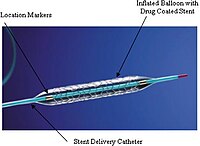
Photo from wikipedia
Objective— Arterial calcification and stiffening increase the risk of reconstruction failure, amputation, and mortality in patients with peripheral arterial disease, but underlying mechanisms and prevalence are unclear. Approach and Results—… Click to show full abstract
Objective— Arterial calcification and stiffening increase the risk of reconstruction failure, amputation, and mortality in patients with peripheral arterial disease, but underlying mechanisms and prevalence are unclear. Approach and Results— Fresh human femoropopliteal arteries were obtained from n=431 tissue donors aged 13 to 82 years (mean age, 53±16 years) recording the in situ longitudinal prestretch. Arterial diameter, wall thickness, and opening angles were measured optically, and stiffness was assessed using planar biaxial extension and constitutive modeling. Histological features were determined using transverse and longitudinal Verhoeff–Van Gieson and Alizarin stains. Medial calcification was quantified using a 7-stage grading scale and was correlated with structural and mechanical properties and clinical characteristics. Almost half (46%) of the femoropopliteal arteries had identifiable medial calcification. Older arteries were more calcified, but small calcium deposits were observed in arteries as young as 18 years old. After controlling for age, positive correlations were observed between calcification, diabetes mellitus, dyslipidemia, and body mass index. Tobacco use demonstrated a negative correlation. Calcified arteries were larger in diameter but had smaller circumferential opening angles. They were also stiffer longitudinally and circumferentially and had thinner tunica media and external elastic lamina with more discontinuous elastic fibers. Conclusions— Although aging is the dominant risk factor for femoropopliteal artery calcification and stiffening, these processes seem to be linked and can begin at a young age. Calcification is associated with the presence of certain risk factors and with elastic fiber degradation, suggesting overlapping molecular pathways that require further investigation.
Journal Title: Arteriosclerosis, Thrombosis, and Vascular Biology
Year Published: 2018
Link to full text (if available)
Share on Social Media: Sign Up to like & get
recommendations!